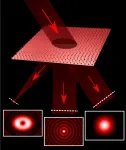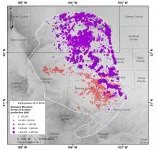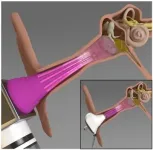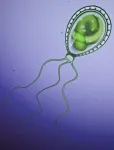FSU researchers find most nitrogen in Gulf of Mexico comes from coastal waters
2021-06-28
(Press-News.org) Almost all of the nitrogen that fertilizes life in the open ocean of the Gulf of Mexico is carried into the gulf from shallower coastal areas, researchers from Florida State University found.
The work, published in Nature Communications, is crucial to understanding the food web of that ecosystem, which is a spawning ground for several commercially valuable species of fish, including the Atlantic bluefin tuna, which was a focus of the research.
"The open-ocean Gulf of Mexico is important for a lot of reasons," said Michael Stukel, an associate professor in the Department of Earth, Ocean and Atmospheric Science and a co-author of the paper. "It's a sort of ocean desert, with very few predators to threaten larvae, which is part of what makes it a good spawning ground for several species of tuna and mahi-mahi. There are all kinds of other organisms that live out in the open ocean as well."
The food web in the Gulf of Mexico that supports newly born larvae and other organisms starts with phytoplankton. Like plants on land, phytoplankton need sunlight and nutrients, including nitrogen, to grow. The researchers wanted to understand how the nitrogen they need was entering the gulf.
They considered a few hypotheses. Their first idea was that nitrogen may have been coming from the deep ocean. Another was that a type of phytoplankton known as a nitrogen fixer was supplying the nutrient to larvae. Finally, they considered that nitrogen might be entering the open ocean from shallower areas of the coast.
By combing measurements made at sea while on research cruises in 2017 and 2018 with information from satellite observations and models, they found that organic matter coming from the coasts is responsible for more than 90 percent of nitrogen coming into the open ocean in the gulf.
Scientists already knew that large, swirling eddies act like slow-moving storms in the ocean and move water from shallower areas near the coast into the interior of the gulf. The researchers believe the nitrogen is probably moved in those eddies, although they didn't answer that question in this study.
Climate change is affecting how water near the surface of the ocean and deeper water mix. Understanding how a changing climate will affect these lateral currents is a harder question to answer.
It's an important part of the ecosystem to understand because the survival of larval tuna and other species that reproduce in the open-ocean Gulf of Mexico is tied to currents that link coastal regions with the nutrient-poor open ocean.
"If we want to understand how this ecosystem will respond to future climate change, we need to understand how all of these lateral transports work in the ocean," Stukel said. "Scientists studying biogeochemical balances -- especially in basins enclosed by productive coasts, which is the situation in the Gulf of Mexico -- should closely consider how lateral transport affects those ecosystems."
INFORMATION:
This work was led by recently graduated FSU doctoral student Thomas Kelly. It was supported by the National Oceanic and Atmospheric Association, the National Science Foundation, NASA, the National High Magnetic Field Laboratory and the State of Florida. Researchers from Scripps Institution of Oceanography and the University of Hawaii at Manoa were co-authors on this study.
[Attachments] See images for this press release:
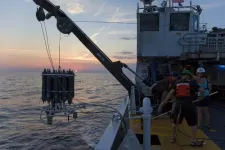
ELSE PRESS RELEASES FROM THIS DATE:
2021-06-28
LAWRENCE -- Despite facing cultural and political pushback, the evidence remains clear: Face masks made a difference in Kansas.
"These had a huge effect in counties that had a mask mandate," said Donna Ginther, the Roy A. Roberts Distinguished Professor of Economics and director of the Institute for Policy & Social Research at the University of Kansas. "Our research found that masks reduced cases, hospitalizations and deaths in counties that adopted them by around 60% across the board."
Ginther's article "Association of Mask Mandates and COVID-19 ...
2021-06-28
Washington, DC--Location, location, location--when it comes to the placement of wind turbines, the old real estate adage applies, according to new research published in Proceedings of the National Academy of Sciences by Carnegie's Enrico Antonini and Ken Caldeira.
Turbines convert the wind's kinetic energy into electrical energy as they turn. However, the very act of installing turbines affects our ability to harness the wind's power. As a turbine engages with the wind, it affects it. One turbine's extraction of energy from the wind influences the ability of its neighbors to do the same.
"Wind is never going to 'run dry' as an energy resource, but our ability to harvest it isn't infinitely scalable either," Antonini explained. "When wind turbines ...
2021-06-28
The ability to precisely control the various properties of laser light is critical to much of the technology that we use today, from commercial virtual reality (VR) headsets to microscopic imaging for biomedical research. Many of today's laser systems rely on separate, rotating components to control the wavelength, shape and power of a laser beam, making these devices bulky and difficult to maintain.
Now, researchers at the Harvard John A. Paulson School of Engineering and Applied Sciences have developed a single metasurface that can effectively tune the different properties of laser light, ...
2021-06-28
In the context of recent debate over the FDA's approval of aducanumab, it's refreshing to learn about a model of Alzheimer's neurodegeneration that doesn't start with the pathogenic proteins amyloid or Tau.
A new paper in Alzheimer's & Dementia from Emory neuroscientist Shan Ping Yu and colleagues focuses on an unusual member of the family of NMDA receptors, signaling molecules that are critical for learning and memory. Their findings contain leads for additional research on Alzheimer's, including drugs that are already FDA-approved that could be used preventively, and genes ...
2021-06-28
Deployable structures -- objects that transition from a compact state to an expanded one -- are used everywhere from backyards to Mars. But as anyone who has ever struggled to open an uncooperative folding chair knows, transforming two-dimensional forms into three-dimensional structures is sometimes a challenge.
Now, researchers from the Harvard John A. Paulson School of Engineering and Applied Sciences (SEAS) and the Harvard Graduate School of Design have developed a deployable system that is light, compact, inexpensive, easy to manufacture, and, most importantly, easy to deploy. By harnessing the mechanical instabilities in curved beams, the system can transform objects into elaborate and customizable 3D configurations on a range of scales, from large-scale furniture to small medical ...
2021-06-28
Boulder, Colo., USA: Subsurface carbon sequestration--storing carbon in
rocks deep underground--offers a partial solution for removing carbon from
the atmosphere. Used alongside emissions reductions, geologic carbon
sequestration could help mitigate anthropogenic climate change. But like
other underground operations, it comes with risks--including earthquakes.
Geophysicists are still working to understand what can trigger
human-induced earthquakes, which have been documented since the 1960s. A
new study, published in Geology on Thursday, explores why part of
a heavily produced oilfield in the U.S. has ...
2021-06-28
Middle ear infections, also known as otitis media, affect more than 80% of the children in the U.S. In a new study, researchers have designed a miniaturized 3D-printed device to inactivate Pseudomonas aeruginosa, a common bacterium that causes the infection.
The device--a microplasma jet array--generates plasma, which is composed of charged particles and reactive molecules that have been previously shown to inactivate various pathogens. "This is the first time anyone has tried treating middle ear infections using plasma technology," said Jungeun Won, a graduate student in the Boppart lab. "Usually, the treatment involves using ...
2021-06-28
HUNTINGTON, W.Va. - According to researchers at Marshall University, a maternal diet rich in Omega-3 fatty acids protects from breast cancer development in offspring. In a new study recently published by Frontiers in Cell and Developmental Biology, researchers noted a significant difference in mice from mothers that were fed a diet rich in canola oil, compared with mothers fed a diet rich in corn oil. A maternal Omega 3-rich diet affected genome-wide epigenetic landscape changes in offspring and potentially modulated gene expression patterns.
Dr. Ata Abbas, a former postdoctoral research fellow in Marshall's Department of Biological Sciences, headed a research team under the leadership ...
2021-06-28
New Brunswick, N.J. (June 28, 2021) - A Rutgers-led study sheds new light on the evolution of photosynthesis in plants and algae, which could help to improve crop production.
The paper appears in the journal New Phytologist.
The scientists reviewed research on the photosynthetic amoeba Paulinella, which is a model to explore a fundamental question about eukaryote evolution: why was there a single origin of algae and plants? That is, why did photosynthesis by primary plastid endosymbiosis not originate multiple times in the tree of life?
Photosynthesis is the process by which plants and other organisms use sunlight to synthesize ...
2021-06-28
A first-of-its-kind longitudinal study of infant curiosity found that months-old babies most captivated by magic tricks became the most curious toddlers, suggesting a pre-verbal baby's level of interest in surprising aspects of the world remains constant over time and could predict their future cognitive ability.
"Something about a baby's curiosity about magic tricks is predicting how curious they become as preschoolers," said Lisa Feigenson, co-director of the Johns Hopkins University Laboratory for Child Development. "What the data suggest is that some three-year-olds have a leg up or seem particularly well positioned to learn a lot about the world."
The findings appear today in Proceedings of the National Academy of Sciences.
Until this study, little was known about curiosity ...
LAST 30 PRESS RELEASES:
[Press-News.org] FSU researchers find most nitrogen in Gulf of Mexico comes from coastal waters


